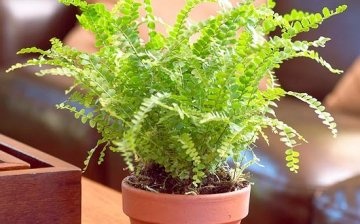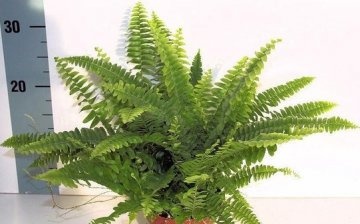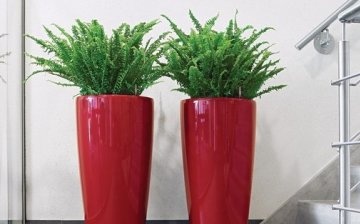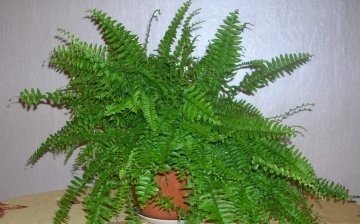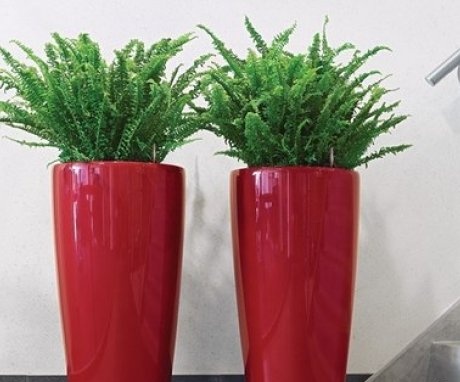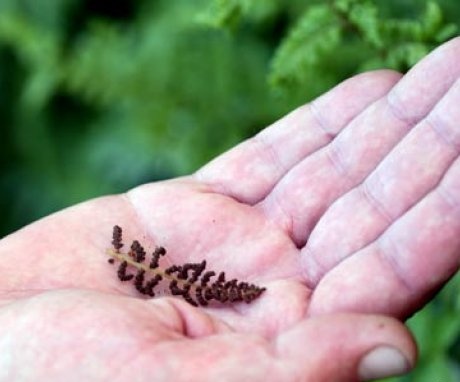Fern care - a helpful guide for the grower
Fern is one of the most ancient plant species. It can be found everywhere - in forests, in swamps, in lowlands, in rocky crevices, in the tropics and subtropics. The most spectacular and huge in height ferns grow in warm and damp areas. They will always be associated with something distant and ancient, with the era of dinosaurs and the beginning of beginnings.
The amazing structure and variety of forms of the fern allows gardeners and flower growers to decorate gardens and rooms with it. The unpretentiousness and wondrous, lush greenery of the plant attracts attention. Ferns are often planted in hanging pots. So he becomes the center of attention in a greenhouse or room, garden or greenhouse. In order to grow this amazing plant, you need to know some of the nuances and basic rules for care, reproduction and growing conditions. This short guide will tell you about all the features of growing ferns at home.
Content
- Fern description
- Required growing conditions
- How to care for a fern
- Reproduction methods
- Diseases and pests
Fern description
Fern is a bush, the leaf-like part of which can reach two meters. It consists of a rosette with feathery leaves emerging from it, which are called vayas. The shape of the leaf-shaped organs can be very diverse - carved, dissected, lanceolate, lace at the edges, round, oval. As it grows, a spore forms in the lower part of the dissected leaf, with the help of which the fern reproduces in the wild. The greens of the bush are dense, often bright green.
The color of the fern depends on its species and variety, it varies from bright green to brown, dark brown with spots.
The plant prefers warm and damp places, but it can grow on poor soils, in a rather harsh climate. Unpretentiousness and the ability to adapt to the climate allowed the fern to survive - the plant has 400 million years of evolution.
There are more than 300 genera of ferns and more than 10,000 plant species in the world. The variety of varieties is amazing. Only a few species are widespread in Russia.
Among them are:
- Nephrolepsis
- Asplenium nesting
- Woodward
- Ligodium
- Polypodium
Nephrolepsis is considered the most popular and widely used in Russian floriculture. He gets along well in rooms and does not present any hassle when growing... It has a rather bright and dense greenery. Grows in height and width. Florists often breed nephrolepsis in hanging pots, which looks very impressive and beautiful.
In addition to its decorative qualities, the fern also has healing properties. Throughout the history of mankind, it has been used as a medicine for coughs, arthritis, and diseases of the lower extremities. At the royal courts, special types of ferns were grown, which contained poison - it was used for its intended purpose. In Asian countries, fern is more often used as a food product, salads are prepared from it, added to soups and roasts. As for Russia, the plant was of a sacred nature.The fern never blooms, but our ancestors thought differently. They argued that on the day of Ivan Kupala, you can see the unearthly beauty of a fern bloom. Those who succeed will have unusual abilities and become closer to the gods.
The interesting structure of the plant, the luxurious look of the bush and the rich history of the fern attracts flower growers. It is not difficult to grow it if the basic conditions, rules of care and planting are observed.
Required growing conditions
Despite its unpretentiousness, the fern loves warm and rather damp growing places. But there are some plant varieties that tolerate frost and poor soils well.
The main condition for abundant growth and lush greenery is lighting:
- It should be bright, but diffuse.
- The optimal direction of the window for cultivation fern will become east and west.
- The leaf-like organs of the plant should not be exposed to direct sunlight. A room in the southern part of the house is perfect, but a flowerpot with a fern should not be on the window, but be away from it.
- Dark and cold rooms will not promote plant growth. Try to give the fern plenty of room so that the growing greenery doesn't bump into anything.
The air temperature in the room should be 21 ° -23 °. Too high temperatures require constant soil and air moisture. To grow ferns in the garden, it is necessary to purchase frost-resistant varieties designed specifically for our climate. The plant is very fond of water, so experienced gardeners recommend placing the flowerpot in a larger container filled with peat. It is constantly moisturized and thus occurs watering... Chances of waterlogging and moisture accumulation in root system are reduced to zero.
Fern soil should be light.
It includes peat, turf, humus, sand and leafy soil. The composition of the soil depends on the variety and type of fern. But it should always be light and slightly sour. All these simple growing conditions are easy to observe in an apartment. By providing a young plant with all these aspects, the grower will have a lush, bright green bush.
How to care for a fern
Care behind a fern does not imply any special skill or skill. The plant must be watered 2-3 times a week with settled water at room temperature. Constantly monitor the moisture content of the soil, but do not overfill it, otherwise root rot may occur and the plant will die. If the air is too dry, spray the greenery with warm water. The fern is very fond of sprinkling. Do not allow the earthen coma to dry out.
Fern feeding:
- Plant feeding is carried out at transplant and dividing the bush... Complex organic is used fertilizer.
- Feeding should be done as rarely as possible. Enough once - in the spring. The fact is that with a well-chosen soil, the fern does not need additional fertilization, it grows well anyway.
As the root system grows, it must be transplanted into a larger flowerpot with new soil. At this moment, the plant is fed. The fern pot is best used with a tray where excess water drains.
Many people use double bottom containers where drainage or peat is laid out.
These components absorb water and maintain moisture in the plant's root system. In this way, the amount of watering can be reduced without harming the fern. Observing the rules of care, the florist will be able to grow a large and dense bush, the leaves of which will effectively hang down and remind of a tropical forest.
Reproduction methods
In the wild, the fern reproduces by spores that form on the underside of the leaf at a certain stage of growth. Spores fall to the ground and sprout. At home, about the same process takes place, but under the control of a gardener.
Reproduction using spores will allow you to get a lot of seedlings. The collected spores are spread on the soil surface and covered with foil. The air temperature during spore germination should be at least 23 °. Watering is carried out not on the surface, but from below. Warm and settled water is poured into the pallet. Thus, the land takes just as much water as is necessary for the germination of the spores.
Usually, sprouts appear in 20-25 days.
At this point, the film is removed. When several independent leaves are formed, carry out pick... The spore plant grows for a long time. Therefore, you should be patient.
The second and most common breeding method is dividing the bush when transplant:
- The fern is removed from an old flowerpot, the root system is divided into parts and planted in different pots.
- Florists advise adding charcoal to the soil with this method of reproduction. This measure will disinfect the soil and prevent roots damaged during division from rotting.
- After the procedure, the plant is placed in a fairly cool and shaded place. This can be a room in the northern part of the house with a temperature no higher than 20 °.
Fern propagation is fairly easy if you have an already mature plant. Any method will be interesting. When multiplying from spores, the entire natural life cycle of the plant can be observed, which is always a fun activity.
Diseases and pests
With proper fern care, the risk of diseases and pests is reduced to zero. However, often beginner growers pour over the fern. The plant begins to shed its leaves and turn yellow. In this case, you must stop watering... Remember, it's better to dry it out, not overfill it.
The most important enemy of the plant is the scale insect and aphids, but it appears only if the air is too dry.
Therefore, it is very important to carry out sprinkling as a prevention of the appearance of the scabbard. But if it appeared and you saw the first signs of wilting of the plant, you need to remove the pest manually using a cotton pad moistened with alcohol. If you cannot remove the pest and there is already a lot of it, cut off all the greens and grow new shoots. The fact is that the fern does not tolerate processing insecticides. Therefore, gardeners are advised to cut off the affected foliage.
Less commonly, "Karbofos" or "Akteliku" are used to get rid of pests. Drugs diluted more than indicated in the instructions for the same reason - poor tolerance of chemicals by the fern. Root rot, foliage and pests can be prevented very easily. Do not overfill the plant and observe the temperature regime. Care and cultivation of a fern as ancient as the world is actually very simple. Compliance with simple rules and tips will allow the grower to grow a luxurious, bright green and dense bush. Good luck!
More information can be found in the video.



